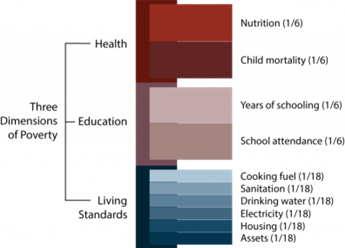There are no items in your cart
Add More
Add More
| Item Details | Price | ||
|---|---|---|---|
GS 2: ISSUES OF POVERTY AND HUNGER
Why in News?
UN praises 'remarkable' India as 415 million exit poverty levels in 15 years.
Context:
· The latest update of the global Multidimensional Poverty Index (MPI) was released by the United Nations Development Programme (UNDP) and the Oxford Poverty and Human Development Initiative (OPHI) at the University of Oxford.
· It said that 25 countries, including India, successfully halved their global MPI values within 15 years, showing that rapid progress is attainable.
What is MDPI?
· The index is a key international resource that measures acute multidimensional poverty across more than 100 developing countries.
· The global MPI both monitors poverty reduction and informs policy, showing how people experience poverty in different aspects of their daily lives – from access to education and health, to living standards such as housing, drinking water, sanitation, and electricity.
· It was first launched in 2010 by the OPHI and the Human Development Report Office of the UNDP.
· The MPI monitors deprivations in 10 indicators spanning health, education and standard of living and includes both incidence as well as intensity of poverty.
What are the Indicators used in Measuring it?

When a Person is said to be Poor?
· A person is multidimensionally poor if she/he is deprived in one third or more (means 33% or more) of the weighted indicators (out of the ten indicators).
· Those who are deprived in one half or more of the weighted indicators are considered living in extreme multidimensional poverty.
Highlights of Latest MDPI 2023 Report:
· The report demonstrates that poverty reduction is achievable. However, the lack of comprehensive data over the COVID-19 pandemic poses challenges in assessing immediate prospects.
· The analysis of trends from 2000 to 2022, focused on 81 countries with comparable data over time, reveals that 25 countries successfully halved their global MPI values within 15 years, showing that rapid progress is attainable.
· These include Cambodia, China, Congo, Honduras, India, Indonesia, Morocco, Serbia, and Viet Nam.
· Countries halved their MPI in periods as short as four to 12 years, demonstrating the feasibility of the Sustainable Development Goal (SDG) target of halving poverty according to national definitions within 15 years.
· Despite these encouraging trends, the lack of post-pandemic data for most of the 110 countries covered by the global MPI restricts understanding of the pandemic's effects on poverty.
· This suggests that child poverty will continue to be a pressing issue, particularly in relation to school attendance and undernutrition.
· According to the 2023 release, 1.1 billion out of 6.1 billion people (just over 18%) live in acute multidimensional poverty across 110 countries.
· Sub-Saharan Africa (534 million) and South Asia (389 million) are home to approximately five out of every six poor people.
· Nearly two-thirds of all poor people (730 million people) live in middle-income countries, making action in these countries vital for reducing global poverty.
· Although low-income countries constitute only 10% of the population included in the MPI, these are where 35% of all poor people reside.
· Children under 18 years old account for half of MPI-poor people (566 million). The poverty rate among children is 27.7%, while among adults it is 13.4%.
· Poverty predominantly affects rural areas, with 84% of all poor people living in rural areas. Rural areas are poorer than urban areas across all regions of the world.
· The MPI sheds light on the complexity of poverty – where different indicators contribute to people's experience of poverty differently, varying from region to subnational region, and between and within communities.
· Ensuring that the data on global poverty is up-to-date and comprehensive is a crucial first step in addressing these challenges and maintaining progress towards a more equal world.
India Specific Findings:
· India surpassed China to become the world’s most populous nation with 142.86 crore people, according to UN data.
· A total of 415 million people moved out of poverty in India within just 15 years from 2005/2006 to 2019/2021 highlighting the remarkable achievement by the world's most populous nation.
· Additionally, the poorest states and groups, including children and people in disadvantaged caste groups, had the fastest absolute progress.
Poverty Incidence:
· Poverty incidence falling from 55.1 per cent in 2005/2006 to 16.4 per cent in 2019/2021.
· In 2005/2006, about 645 million people were in multidimensional poverty in India, with this number declining to about 370 million in 2015/2016 and 230 million in 2019/2021.
Nutrition:
· According to the report, people who are Multi dimensionally poor and deprived under the nutrition indicator in India declined from 44.3 per cent in 2005/2006 to 11.8 per cent in 2019/2021, and child mortality fell from 4.5 per cent to 1.5 per cent.
Cooking Fuel:
· Those who are poor and deprived of cooking fuel fell from 52.9 per cent to 13.9 per cent
Sanitation:
· Those deprived of sanitation fell from 50.4 per cent in 2005/2006 to 11.3 per cent in 2019/2021, according to the report.
Drinking Water:
· In the drinking water indicator, the percentage of people who are multi dimensionally poor and deprived fell from 16.4 to 2.7 during the period, electricity (from 29 per cent to 2.1 per cent)
Housing:
· Housing fell from 44.9 per cent to 13.6 per cent.
Electricity:
· Percentage of people who were multi dimensionally poor and deprived fell from electricity from 29 per cent to 2.1 per cent)
Performance of States:
· Uttar Pradesh, Bihar, and Jharkhand, as per the report, which were initially among the poorest in the country, reduced poverty faster in absolute terms than the national average thereby narrowing the poverty gap.
Rural-Urban Poverty levels:
· The prevalence of poverty fell from 36.6 percent in 2015/2016 to 21.2 percent in 2019/2021 in rural areas and from 9.0 percent to 5.5 percent in urban areas.
Poverty among Children:
· Children, the poorest age group, saw the fastest reduction in MPI value. Poverty fell from 34.7 percent to 21.8 percent among children and from 24.0 percent to 13.9 percent among adults.
Sustainable development goal target 1.2 is to reduce at least by half the proportion of men, women and children of all ages living in poverty in all its dimensions.
The UNDP report says that India’s progress shows that this goal is feasible even on a large scale.
Mains Question:
Q: The MPI as a poverty index can be pictured as a stacked tower of the interlinked deprivations experienced by poor individuals. In this Context, Discuss the latest findings of MDPI 2023

{{Chandra Sir }}

